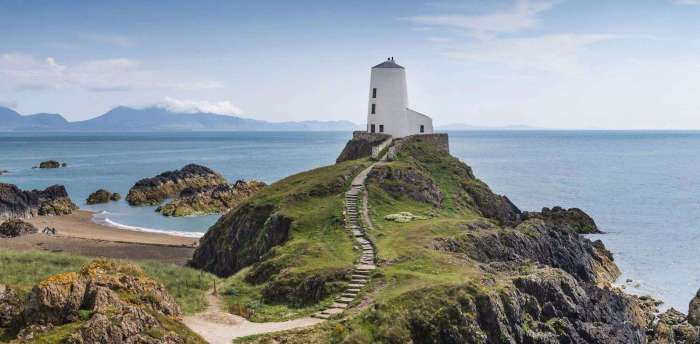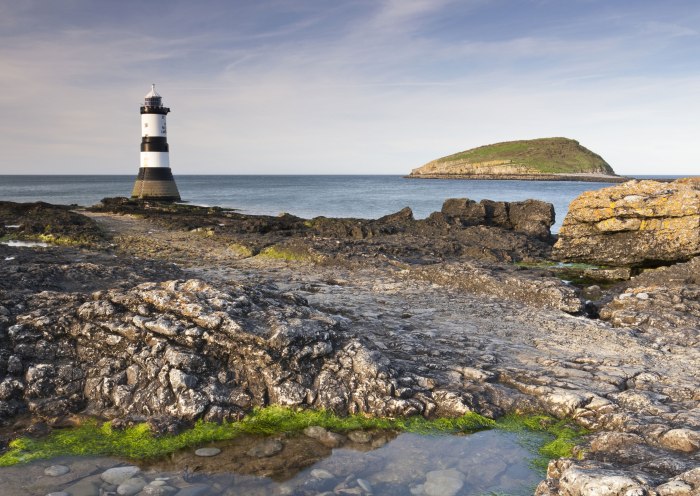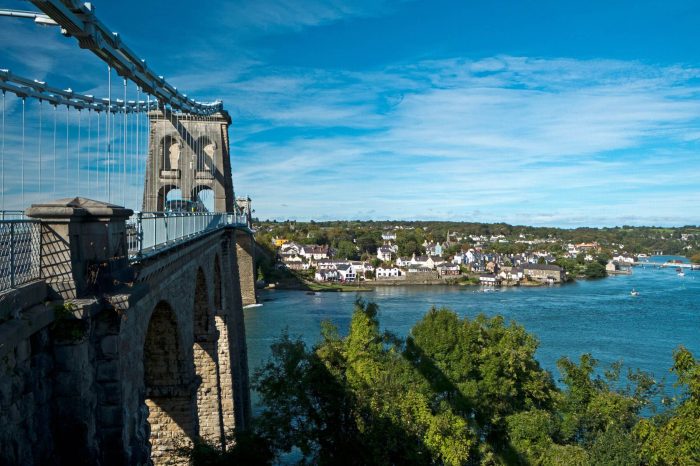Nestled off the coast of North Wales, Anglesey is an island steeped in history, culture, and natural beauty. From its ancient Celtic roots to its vibrant present, Anglesey offers a captivating journey through time and tradition.
Anglesey’s strategic location and unique geography have shaped its destiny, leaving behind a rich tapestry of historical sites, cultural heritage, and economic opportunities. Its rugged coastline, rolling hills, and fertile valleys have played a pivotal role in the island’s development, making it a place of both historical significance and modern prosperity.
History of Anglesey
Anglesey, an island off the coast of northwest Wales, boasts a rich and captivating history that has shaped its unique character. From its early inhabitants to its Roman occupation and medieval period, Anglesey has played a pivotal role in Welsh mythology and culture.
The earliest known inhabitants of Anglesey were the Celts, who arrived around 600 BC. They established settlements and developed a thriving culture on the island. In the 1st century AD, the Romans invaded Anglesey and established a military presence. The Romans constructed forts and roads, and Anglesey became part of the Roman province of Britannia.
Medieval Period
After the Romans left Britain in the 5th century AD, Anglesey was ruled by a succession of Welsh princes. The island became a center of learning and culture, and it was home to several important monasteries. In the 13th century, Anglesey was conquered by the English, and it remained under English rule until the 16th century.
Welsh Mythology and Culture
Anglesey holds a significant place in Welsh mythology and culture. It is said to be the birthplace of the legendary hero Branwen, and it is also associated with the druid priestesses known as the Coraniaid. Anglesey is also home to several ancient monuments, including the prehistoric standing stones of Bryn Celli Ddu and the medieval castle of Beaumaris.
Geography of Anglesey
Anglesey, also known as Ynys Môn in Welsh, is an island off the northwest coast of Wales. It is the largest island in Wales and the second largest in the UK. Anglesey is separated from the mainland by the Menai Strait, which is spanned by two bridges, the Menai Suspension Bridge and the Britannia Bridge.
The island has a varied geography, with a coastline of over 120 miles (190 km). The coastline is characterized by sandy beaches, rocky cliffs, and several small islands. The interior of the island is mostly flat, with some low hills. The highest point on the island is Mynydd Bodafon, which is 569 feet (173 m) high.
Anglesey, an enchanting island off the coast of Wales, boasts a rich tapestry of historical and natural wonders. Its captivating landscapes and ancient monuments have earned it recognition as one of the many UNESCO World Heritage Sites in the United Kingdom.
Anglesey’s unique cultural heritage and stunning natural beauty continue to draw visitors from far and wide, eager to explore its timeless treasures.
Mountains
Anglesey has a number of small mountains, including:
- Mynydd Bodafon (569 feet)
- Mynydd Twr (544 feet)
- Mynydd y Garn (492 feet)
These mountains are popular with hikers and climbers, and offer stunning views of the island and the surrounding countryside.
Rivers
Anglesey has a number of rivers, including:
- The Afon Alaw
- The Afon Cefni
- The Afon Goch
These rivers provide water for the island’s agriculture and industry, and are also popular for fishing and kayaking.
Unique Geography, Anglesey
Anglesey’s unique geography has shaped its history and economy. The island’s coastline has made it a popular destination for tourism and recreation, and the island’s flat interior has made it suitable for agriculture. The island’s proximity to the mainland has also made it a strategic location for trade and defense.
Economy of Anglesey

Anglesey’s economy is a blend of traditional and modern industries, shaped by its unique geography and history. Agriculture, tourism, and manufacturing form the backbone of the island’s economic activity, providing employment and contributing to its overall prosperity.
Agriculture
Agriculture remains a significant sector in Anglesey, with a strong focus on livestock farming. The island’s lush pastures support a thriving cattle and sheep industry, and Anglesey beef and lamb are renowned for their quality. Dairy farming is also prevalent, and the island produces a range of award-winning cheeses. In addition to livestock, Anglesey farmers cultivate a variety of crops, including potatoes, barley, and wheat.
Tourism
Tourism is a rapidly growing sector in Anglesey, attracting visitors from across the UK and beyond. The island’s stunning coastline, picturesque villages, and historical landmarks make it a popular destination for both domestic and international tourists. Key attractions include the Snowdonia National Park, the Menai Strait, and Beaumaris Castle. Tourism-related businesses, such as hotels, restaurants, and gift shops, contribute significantly to the local economy.
Manufacturing
Anglesey has a long history of manufacturing, with a particular focus on the aerospace and automotive industries. The island is home to several major manufacturing plants, including those of Airbus and Ford. These industries provide high-skilled jobs and contribute to the island’s economic stability. In recent years, Anglesey has also seen the growth of renewable energy manufacturing, with the development of wind and tidal power projects.
Challenges and Opportunities
Despite its economic strengths, Anglesey faces several challenges. The island’s remote location and limited infrastructure can make it difficult to attract and retain businesses. Additionally, the island’s economy is heavily dependent on tourism, which can be vulnerable to fluctuations in visitor numbers.
However, Anglesey also has a number of opportunities for economic growth. The island’s natural beauty and cultural heritage make it an ideal destination for eco-tourism and heritage tourism. Additionally, the development of renewable energy projects and the growth of the aerospace and automotive industries provide opportunities for diversification and job creation. With continued investment and support, Anglesey can continue to build a prosperous and sustainable economy.
Culture and Society of Anglesey

Anglesey possesses a rich cultural heritage, influenced by its Celtic roots and maritime history. The island’s unique identity is reflected in its language, music, and traditions.
Language
Welsh, a Celtic language, is widely spoken in Anglesey, particularly in the north and west. The island is home to several Welsh-language schools and cultural organizations, contributing to the preservation and promotion of the language.
Music
Anglesey has a strong musical tradition, with a vibrant folk music scene. The island is known for its male voice choirs, which perform traditional Welsh songs and hymns. The Anglesey Eisteddfod, an annual festival, showcases the island’s musical talent and cultural heritage.
Traditions
Anglesey’s cultural traditions are deeply rooted in its agricultural and maritime past. The island is home to numerous historical sites, including ancient hillforts, churches, and lighthouses. Traditional festivals and events, such as the Menai Strait Regatta and the Beaumaris Food Festival, celebrate the island’s unique character and community spirit.
Social Issues and Challenges
Despite its cultural richness, Anglesey faces several social issues and challenges. The island has experienced population decline and economic challenges in recent years. As a result, some communities have struggled with unemployment, poverty, and access to essential services.
Anglesey’s geographical isolation can also pose challenges for its residents. The island is connected to the mainland by two bridges, which can be subject to closures during inclement weather. This can impact access to healthcare, education, and employment opportunities.
The island’s community is working to address these challenges through various initiatives, including promoting economic development, improving infrastructure, and supporting vulnerable populations.
Tourism in Anglesey
Anglesey, an island off the coast of North Wales, is a popular tourist destination known for its stunning natural beauty, rich history, and diverse attractions. The island’s tourism industry has significantly impacted its economy and infrastructure, contributing to its overall prosperity.
Anglesey’s beaches are a major draw for tourists, with miles of golden sands and clear waters. Some of the most popular beaches include Rhosneigr, known for its surfing and watersports, and Trearddur Bay, renowned for its scenic views and family-friendly atmosphere.
Anglesey, an island off the coast of Wales, offers a unique blend of history, culture, and natural beauty. From its medieval castles to its stunning coastline, Anglesey has something to offer everyone. Whether you’re looking for a relaxing getaway or an adventure-filled vacation, Anglesey is the perfect destination.
And if you’re looking for even more luxury, be sure to check out our guide to the top luxury travel destinations. Anglesey is sure to exceed your expectations.
Beyond its beaches, Anglesey is home to numerous historical sites and landmarks. Beaumaris Castle, a 13th-century fortress built by Edward I, is a popular attraction, as is Penrhyn Castle, a 19th-century country house surrounded by beautiful gardens.
The island’s natural beauty is another major tourist attraction. The Anglesey Coastal Path, a 125-mile walking trail, offers breathtaking views of the coastline, while the Snowdonia National Park, just across the Menai Strait, provides opportunities for hiking, climbing, and other outdoor activities.
Tourism has had a positive impact on Anglesey’s economy, creating jobs and supporting local businesses. The island’s infrastructure has also been improved to accommodate the influx of tourists, with new roads, bridges, and other amenities being built.
Anglesey, a beautiful island off the coast of Wales, is a must-visit destination in 2024. With its stunning coastline, charming villages, and rich history, Anglesey offers a perfect blend of relaxation and adventure. Whether you’re looking for a peaceful retreat or an active getaway, Anglesey has something for everyone.
For more travel inspiration, be sure to check out the best travel destinations for 2024.
Transportation in Anglesey

Anglesey’s transportation infrastructure is a vital component of the island’s economy and accessibility. The island is connected to the mainland by two bridges, the Britannia Bridge and the Menai Suspension Bridge, both of which carry road and rail traffic. In addition, there are several ferries that connect Anglesey to the mainland and other islands in the region.
The road network on Anglesey is generally good, with a mix of A-roads, B-roads, and minor roads. However, there are some areas of the island where the roads are narrow and winding, which can make driving difficult. The A55 expressway, which runs along the north coast of the island, is the main road link to the mainland.
Challenges and Opportunities
One of the challenges facing transportation on Anglesey is the island’s geography. The island is surrounded by water, which makes it difficult to build new roads and bridges. In addition, the island’s terrain is hilly, which can make it difficult to build roads that are both safe and efficient.
Despite these challenges, there are a number of opportunities for improving transportation on Anglesey. One opportunity is to improve the public transportation system. The island’s bus service is currently limited, and there are no trains that run on the island. Improving the public transportation system would make it easier for people to get around the island without having to drive.
Another opportunity is to develop new ferry routes. Ferries are a vital link between Anglesey and the mainland, and they can also be used to connect the island to other islands in the region. Developing new ferry routes would make it easier for people to travel to and from Anglesey.
Closure

As a microcosm of Wales, Anglesey embodies the nation’s spirit and resilience. Its rich history, diverse culture, and stunning landscapes continue to captivate visitors and locals alike, making it a destination that offers a truly immersive and unforgettable experience.
Question Bank
What is Anglesey famous for?
Anglesey is renowned for its historical significance, natural beauty, and cultural heritage, including ancient Celtic sites, stunning beaches, and vibrant Welsh traditions.
How do I get to Anglesey?
Anglesey is accessible by car or train via the Menai Suspension Bridge or by ferry from mainland Wales.
What are the must-visit attractions in Anglesey?
Anglesey offers a range of attractions, including Beaumaris Castle, South Stack Lighthouse, Snowdonia National Park, and the picturesque coastal towns of Menai Bridge and Beaumaris.